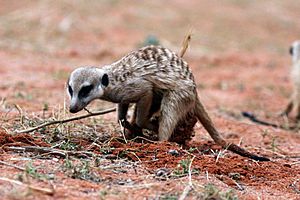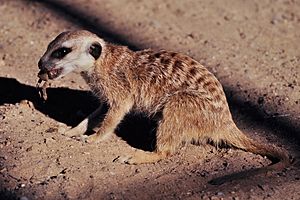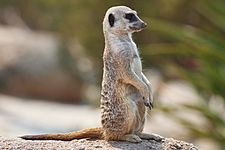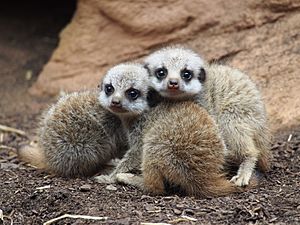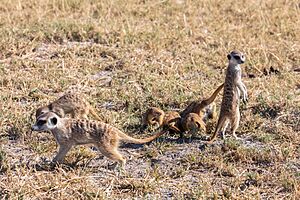Meerkat facts for kids
Quick facts for kids Meerkat |
|
|---|---|
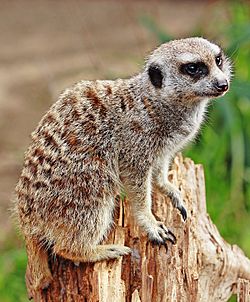 |
|
| Conservation status | |
| Scientific classification | |
| Kingdom: | |
| Phylum: | |
| Class: | |
| Order: | |
| Family: | |
| Genus: |
Suricata
Desmarest, 1804
|
| Species: |
S. suricatta
|
| Binomial name | |
| Suricata suricatta (Schreber, 1776)
|
|
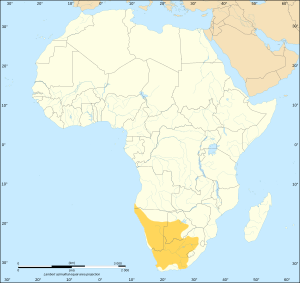 |
|
| Meerkat range | |
A meerkat (Suricata suricatta) is a small mammal that lives in the Kalahari Desert in southern Africa. It is a member of the mongoose family. A group of meerkats is called a "mob" or "gang", and usually all of the meerkats are relatives.
Contents
How meerkats act
Meerkats live in burrows in the ground. They are active during the day, except when hot during the afternoon sun. They also live in large family groups. The group is led by a female and a male. The meerkats are often all family. They get rid of fleas in each other's fur to become friends, which is called "grooming". Sometimes if a minor member is in trouble with the leader it will groom the leader to try and calm them down.
The meerkats help each other. When the family is eating or playing together, one meerkat acts a sentry, and looks out for predators. If he or she sees one, then he gives a chirp and the group runs to a burrow to be safe. Also, when pups are looking for food, adults bring them food and teach them how to eat it.
Before pups start looking for food with the group, they are babysat by older members at the burrow to protect them from danger. Sometimes a female who never gave birth will produce milk for the pups.
Meerkats can share their burrows with many different animals, such as other mongooses and sometimes squirrels who live on the ground. Sometimes even a snake will share the burrow with a meerkat.
Meerkats have many different chirps that they use for different reasons. They have a different chirp for being friends, anger, and for warning of an animal that will eat them.
Eating behavior
Meerkats eat mostly insects, but they also eat lizards, snakes, spiders, birds, plants, eggs and other small mammals.) Like all members of the mongoose family, meerkats cannot be hurt by some venoms, and they eat scorpions (including the stinger) and some snakes, without fear of illness, poison or death. They have no extra body fat, so they must look for food every day and eat food every day.
When the meerkat group is eating, a guard will stand up and look for any animals that might eat its family. If the guard sees an animal, it gives a loud chirp and the family will run to a hole to be safe. Many animals eat meerkats. Most eagles, hawks, and falcons will eat them. Baby meerkats, called "pups" are sometimes also eaten by snakes. Jackals and other big animals that eat meat will sometimes eat meerkats.
When pups are looking for food, they will cry loudly and an adult will come and feed them.
The meerkat body
The meerkat weighs about one and a half pounds and the meerkat is ten to fourteen inches long. The meerkat uses its tail to balance because it stands up on its back legs to look for animals that would eat it. Round the eyes are black patches which lessen the bright light that comes into its eyes. Meerkats have long claws that help them dig and fight. The back of the meerkat is furry and it has stripes to help it not be seen by predators. The front side is black and has no fur because it needs to get warm in the morning to be ready for the day. Meerkats also have ears that can open and close. They close in order to keep sand out when they are burrowing.
Having children
The meerkat is old enough to have children at one year. Meerkats can have one to seven babies at one time. Four is the most common. Meerkats can give birth at any time of the year but like to give birth in spring and summer because there is more food. Female meerkats can have up to three litters in one year. When the babies are born they are pink and have no hair. Their eyes and ears are closed. When they are three weeks old, the mother allows them to get out of the burrow. By this time their eyes and ears have opened and they have light brown fur. The babies cannot be left alone so one of the other meerkats besides the mother stays behind to watch them.
After the mother mates with the father, the babies develop for eleven weeks. Then she gives birth in a burrow. She feeds the babies milk until they start looking for food with the rest of the group, which is when they turn one month old.
The leader of the group is a girl and her mate is the male leader. This pair do not allow other minor members of their family to have babies. If a female does, then the leader kicks her out and sometimes the leader kills her grandchildren. Most of the meerkats in a group are either the leader's brothers and sisters or children.
New meerkat groups form when a female is kicked out and she teams up with a male and starts a new family.
Distribution and habitat
The meerkat occurs in southwestern Botswana, western and southern Namibia, northern and western South Africa; the range barely extends into southwestern Angola. It lives in areas with stony, often calcareous ground in a variety of arid, open habitats with little woody vegetation. It is common in savannahs, open plains and rocky areas beside dry rivers in biomes such as the Fynbos and the Karoo, where the mean yearly rainfall is below 600 mm (24 in). The average precipitation reduces to 100 to 400 mm (3.9 to 15.7 in) towards the northwestern areas of the range. It prefers areas with short grasses and shrubs common in velds, such as camelthorn in Namibia and Acacia in the Kalahari. It is absent from true deserts, montane regions and forests. Population densities vary greatly between places, and are significantly influenced by predators and rainfall. For instance, a study in the Kgalagadi Transfrontier Park, where predation pressure is high, recorded a lower mean meerkat density relative to a ranch with lower occurrence of predators; in response to a 10% decrease in rainfall over a year, the density fell from 0.95 to 0.32/km2 (2.46 to 0.83/sq mi).
Threats and conservation
The meerkat is listed as Least Concern on the IUCN Red List; the population trend appears to be stable. There are no significant threats except low rainfall, which can lead to deaths of entire packs. Research has shown that temperature extremes have negative impacts on Kalahari Desert meerkats. Increased maximum air temperature is correlated with decreased survival and body mass in pups, perhaps as a result of dehydration from water loss during evaporative cooling or decreased water content in food, or from the heavier metabolic costs of thermoregulation on hot days. Higher temperatures are also associated with increased rates of endemic tuberculosis infection; this may be due to decreased immune function resulting from physiological stress, as well as increased male emigration rates observed during heat waves.
Meerkats occur in several protected areas such as the Kgalagadi Transfrontier Park and the Makgadikgadi Pan. The Kalahari Meerkat Project, founded by Tim Clutton-Brock, is a long-term research project run by four different research groups that focuses on understanding cooperative behaviour in meerkats. It began in the Gemsbok National Park but was shifted to the Kuruman River Reserve in 1993.
In culture
Meerkats are generally tame animals. However, they are unsuitable as a pet as they can be aggressive and have a strong, ferret-like odour. In South Africa meerkats are used to kill rodents in rural households and lepidopterans in farmlands. Meerkats can transmit rabies to humans, but yellow mongooses appear to be more common vectors. It has been suggested that meerkats may even limit the spread of rabies by driving out yellow mongooses from their burrows; meerkats are generally not persecuted given their economic significance in crop protection, though they may be killed due to rabies control measures to eliminate yellow mongooses. Meerkats can also spread tick-borne diseases.
Meerkats have been widely portrayed in movies, television and other media. A popular example is Timon from the Lion King franchise, who is an anthropomorphic meerkat. Meerkat Manor (2005–2008), a television programme produced by Oxford Scientific Films that was aired on Animal Planet, focused on groups of meerkats in the Kalahari that were being studied in the Kalahari Meerkat Project. Meerkats populated an acidic floating island in the 2012 film Life of Pi.
Images for kids
See also
 In Spanish: Suricata suricatta para niños
In Spanish: Suricata suricatta para niños



